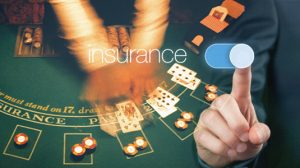Should You Take Partial Insurance?
PostedArticle by Mike Anderson
I have clarified some things from the original posting, mainly that there are benefits to taking partial insurance although it’s not the optimal EV play.
In the game of black when the dealer has an Ace showing you have the options of placing an additional side bet of called the insurance bet. It is usually signified by the dealer asking: Insurance anyone? And is no longer offered when the dealer says: Insurance is closed. What you are betting on in the insurance bet is whether or not the dealer has a 10 as their hole card for a blackjack. It pays of when the dealer has the natural.

This wager has a maximum bet of half the initial wager. If your initial wager is 100 dollars then the maximum value of the insurance wager is $50. The insurance wager has a payout of 2:1. This means that the $50 wager pays $100. When you win the insurance wager you lose the initial wager, so in most cases the cumulative wager for the round is a net push. In cases where the player has a blackjack against a dealers Ace up card, taking insurance is also called even money. This is where the player gets a return equal to that of their initial bet. Even money is one option a player can take to reduce the variance that they may experience. You are giving up some EV here but it will reduce the financial swings.
In the first paragraph I stated that the maximum insurance bet that a player can take is one-half of the original wager. There is no rule that prohibits a player from placing a wager less than the maximum wager. Doing this is known as taking partial insurance. Partial insurance can be used as a hedge bet of sorts. The benefit of taking partial insurance is to reduce the variance that a player will experience. For anyone who has put any significant time in as an advantage gambler knows that the financial swings can be violent and can try the boundaries of your own sanity. So anything we can do to reduce these swings we take advantage of. It’s better for your bottom line, and even better for your mental state.
The foundation of partial insurance for blackjack can be applied to online casinos as well as land based casino. In the online realm reducing variance is desirable because it allows you to prolong your free play offers that are used to lure players into playing. An online casino will offer free play to new and returning players in place of the traditional RFB comps. For instance 888casino is an exciting live casino with real dealers offering Live Roulette, Live Blackjack, Live Baccarat, Casino Hold’em, Three Card Poker and Caribbean Stud Poker, and they have huge selection of tables for each game. Some signup bonuses are specific to certain games while others can be used on every game the casino offers. Depending on how often you play and the wagering amount the promotional offers will vary. When you get these offers from online casinos there are restrictions before you can withdraw the amount. The player has to play a certain number of rounds before withdrawing funds. When playing the minimum number of rounds you want to reduce the variance that you will experience during this short term play so you get the most return on the free play. Taking partial insurance is a good way to do that. You reduce the chances of winning more money but you also reduce the chances of losing all of the free play money.
The mathematically optimal way to play the insurance bet is bet it when the number for the given count is reach. The index numbers provided are dependent on the card counting system being used. Taking partial insurance reduces the EV that can be expected but it also reduces the variance. One of the most efficient counting systems is the Uston APC count. And it is the count that I will be using to apply the partial insurance index numbers to. The values assigned to each card for the Uston APC count is in the table below.
Table 1- Uston APC Values
| Card | Value |
| 2 | 1 |
| 3 | 2 |
| 4 | 2 |
| 5 | 3 |
| 6 | 2 |
| 7 | 2 |
| 8 | 1 |
| 9 | -1 |
| 10 | -3 |
| Jack | -3 |
| Queen | -3 |
| King | -3 |
| Ace | 0 |
The values are added up to determine the running count and then normalized to a ½ deck resolution. For example if there is running count of +15 and 1 ½ decks remaining the true count is 5. 15 divided by 3 equals 5. Also it should be noted that a side count of Aces is kept to help determine the betting amounts. It is not kept to determine the playing options of hitting, standing or doubling or splitting. Aces have a value of +3 for each Ace that the ½ deck segment is rich and -3 for each ½ deck segment is poor. The base line is 2 Aces per ½ deck.
The table below lists the % of full insurance that is to be taken against various hands that a player can have.
| Hand(s) | None | 25% | 50% | 75% | Full | |
| BJ & Any 20 | > 0.5 | 1 | < 1.5 | 1.75 | 2 | |
| Any 19, AA, Hard 11, Hard 10 | 1 | 1.5 | 1.75 | 2 | 2.5 | |
| Hard 8-9, Any 18, A2-A6 | < 1.5 | 1.75 | 2 | 2.5 | 2.75 | |
| Hard 4-12, & 8,8 | 1.5 | > 1.75 | 2.25 | 2.5 | 3 | |
| Hard 13-16 | > 1.5 | 2 | > 2.25 | 2.75 | 3 |
Take the indicated % insurance at the appropriate Index #. > indicates slightly above INDEX #; < indicates slightly below the INDEX #. The index numbers essentially determine the remaining composition of the cards yet to be played. The remaining composition of cards to be played is the basis for gaining an advantage over the house.

Taking partial insurance should be taken to reduce the variance a player may encounter during play. But it will also reduce the maximum EV. This helps reduce emotional swings as well as bank roll swings a player will encounter. This also will add to the confusion of the surveillance crew as they try to evaluate your play to see if you are an advantage player. It will require a little bit of work to implement but it is well worth the effort for a better mental state and increased longevity.
Special thanks to casino gaming expert Nicholas G. Colon for his review and comments on this piece.
Also to LV BEAR and ZIPPY for helping me clarify my insights
I respectfully disagree with Zippy and Bear. Insurance is not simply an unrelated side bet it is instead a wager that is attached to our main bet. If it was simply our goal to maximize expectation then we would wager say 1/6th of our bankroll at a modest edge in order to do so. This would of course be suicide. While EV is an important component of decision making it is not the be all and end all of blackjack decisions. Reducing variance is also an important goal especially because if we reduce variance we can bet more and then generate more EV. I do think there is a role for partial insurance. However contra the author of this blog post I do not believe we should not be partially insuring stiffs. In fact we should not insure stiffs at all below the index and doing so actually increases our variance as we run the risk of losing the insurance wager and losing the hand.
Zippy is correct. The article is just plain wrong. The article should be amended, starting with this sentence at the end of the second paragraph:
“Even money should always be taken when the player has a blackjack against the dealers Ace up card. Doing this gives the player a guaranteed profit for the round.”
The above sentence should read:
The non-counting, non-hole-carding blackjack player should never take even money, and should never take insurance.
And that should end the article.
I have to disagree with your advice.
First of all, if your aim is to minimise variance, then I would have to strongly suggest that you keep your money in the bank and never make any bets.
Secondly, although the bet is called an insurance bet, it has nothing to do with insurance. It does not “protect” a good hand. The insurance bet is purely a bet on the chance that the dealer has a ten as a hole-card when showing an ace. You win or lose the same amount on this bet regardless of the hand that you have. It makes no difference whether you have 16, 20 or even blackjack, the pay-off is the same.
So the decision to bet should be based purely on the mathematical expectation for the insurance bet. If you are not counting cards, then never buy insurance and never take even money. If you are using any count system, then follow the “rule” for that system to decide when to buy insurance. The most accurate count for deciding when to start buying insurance is the Archer 10 count. However, the Archer count is notoriously inaccurate for betting strategy and that’s where the most money is to be made.